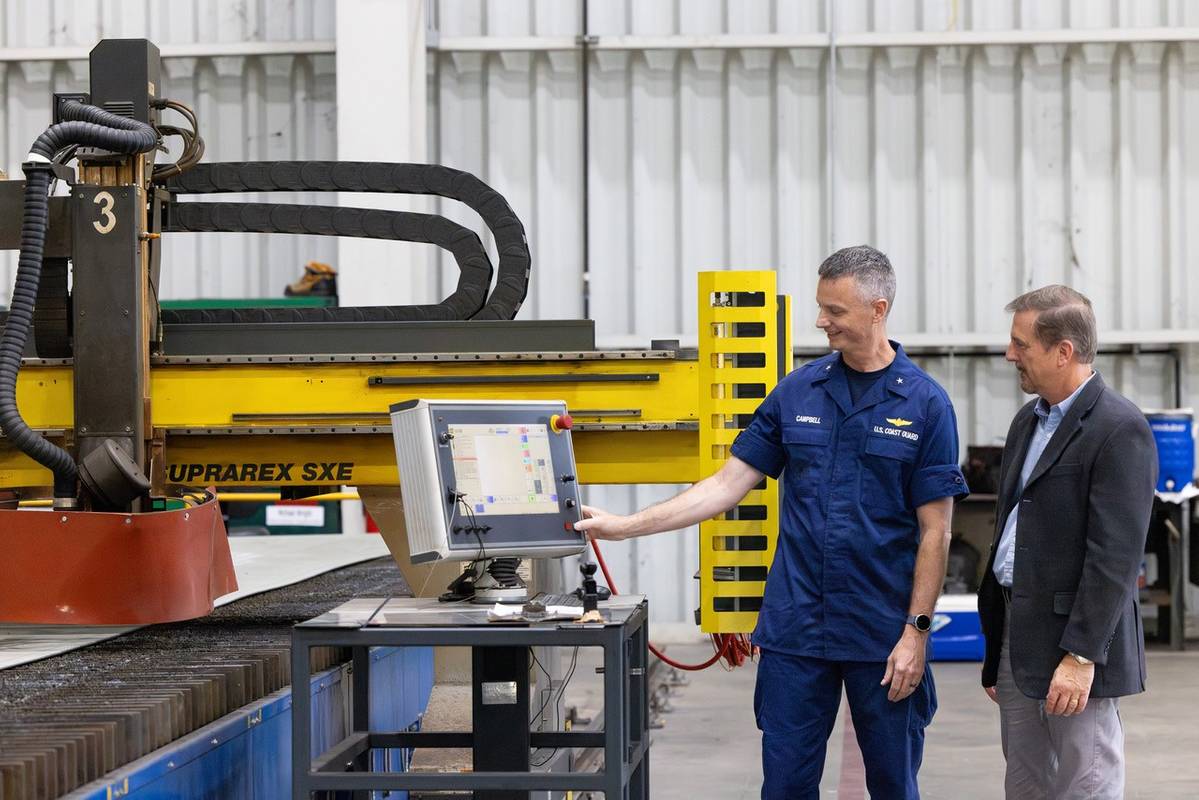Patrol Boats
Offshore Patrol Cutter Construction Starts at Austal USA
The start of Offshore Patrol Cuter Construction in Mobile, Ala. marks new beginnings for both the U.S. Coast Guard and shipbuilder Austal USA.
By Edward Lundquist
Artist’s rendition of the future USCGC Pickering (WMSM 919), which has begun construction at Austal USA in Mobile Ala.
Credit: Austal USAThe Coast Guard and the Austal USA Shipyard of Mobile, Ala., celebrated the commencement of construction of the first Heritage-class offshore patrol cutter (OPC), the future USCGC Pickering (WMSM 919), to be built at the yard, at a ceremony on August 29.
The OPC program will recapitalize the Coast Guard’s aging medium endurance cutters and provide a capability bridge between the service’s national security cutters, which operate in the open ocean, and the fast response cutters which operate closer to shore, according to an Austal USA press release.
Austal USA has a contract to build up to 11 of the OPCs, which the Coast Guard leaders have called their highest acquisition priority.

The first four OPCs are being built at Eastern Shipbuilding at Panama City, Fla. That yard was badly damaged by Hurricane Michael in 2018, which led the Coast Guard to find another builder of OPCs.
The Coast Guard plans to build up to 25 OPCs.
The 360-foot, 4,500-ton OPCs will support all of the Coast Guard missions except icebreaking, and will complement the Coast Guard’s National Security Cutter (NSC) and Fast Response Cutters. The OPCs will be designated as WMSMs, for maritime security cutter-medium).
The OPCs will eventually replace aging 210-foot Reliance-class and 270-foot Famous-class medium endurance cutters (WMECs). The 210s are about 1,200 tons and the 270s are 1,800 tons. Rear Adm. Michael Campbell, the Coast Guard’s director of acquisition, said the OPC is absolutely vital to recapitalizing the capability provided by the Coast Guard’s legacy fleet of 210-foot and 270-foot MECs.
“The two different classes of medium endurance cutters do a lion's share of the Coast Guard missions, particularly around the littorals, as well as the Caribbean and eastern Pacific,” Campbell said.
Of the 16 cutters of the Reliance-class MECs, built between 1962 and 1968, 12 remain in U.S. Coast Guard service. Two were transferred to Sri Lanka and Columbia respectively, and two have been decommissioned. Two others, Decisive and Steadfast are in a special status with their crews transferred to other cutters to alleviate manning shortfalls.
All 13 vessels in the Famous class of MECs, which were built between 1979 and 1989, are still in service.
Coast Guard Commandant Adm. Linda Fagan said in written testimony to Congress in July that the “legacy assets the OPCs will replace have been workhorses for decades and continue to serve the Nation with distinction. Thirteen of these venerable cutters have been in operation for more than 50 years. The MEC fleet will only become more difficult and expensive to maintain, and we will continue to see decreasing readiness and operational availability.”
The lead ship in the class, Argus (WMSM 915) began construction in 2019 at Eastern. Pickering is the fifth OPC to begin construction.
According to the Coast Guard, “Pickering is named after a Revenue Cutter of the same name, built in 1798. That vessel was named in honor of the second Secretary of War, Timothy Pickering. Pickering, who later served as Secretary of State before becoming a U.S. senator and member of the House of Representatives from Massachusetts, advocated for and oversaw the construction of the first frigates built to enforce tariff and trade laws and to prevent smuggling. The cutter is the third Coast Guard vessel to carry the Pickering name. In addition to the Revenue Cutter Pickering, the Coast Guard operated a concrete-hull floating base in the 1920s.”
The Pickering is expected to be delivered to the Coast Guard in late 2027, the Coast Guard said.
The Austal USA yard previously built the all-aluminum littoral combat ships and expeditionary fast transports. The OPC underscores the yard’s shift to steel construction.
“Through continual capital investments, over $500 million to date, Austal USA has expanded its capability and capacity to enable concurrent production of aluminum and steel ships,” a company statement said.
“This (OPC) contract exemplifies the flexibility of our workforce and importance of our steel panel line to Austal USA’s future success,” said Dave Growden, Austal USA’s vice president of new construction programs. “Our multi-talented shipbuilders are well prepared to demonstrate their capability to produce the same high-quality steel ship as they have been producing for our aluminum programs.”
About the Author
Edward Lundquist is a retired naval officer who writes on naval, maritime, defense and security issues. He is a regular contributor to Maritime Reporter & Engineering News, Marine News as well as Marine Technology Reporter.
